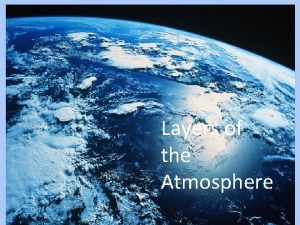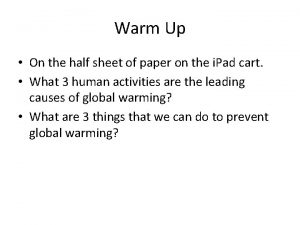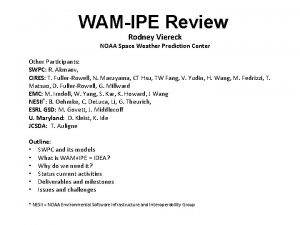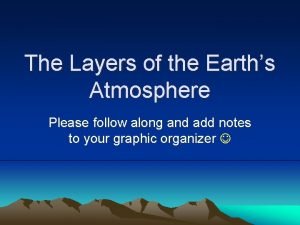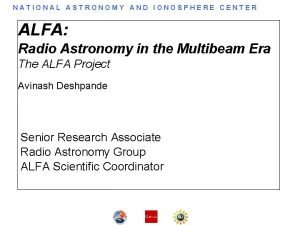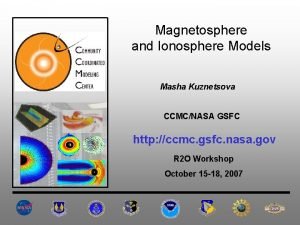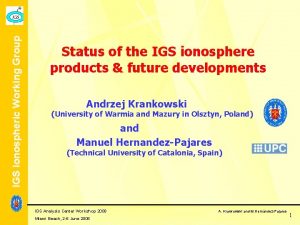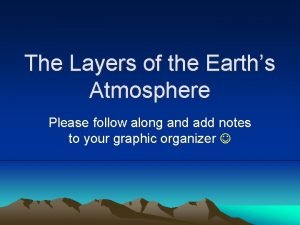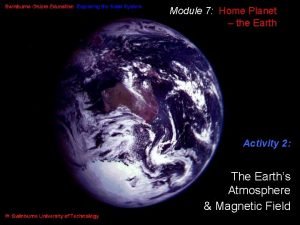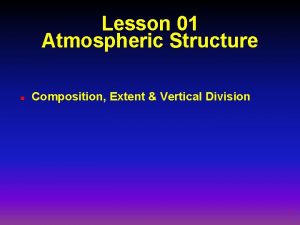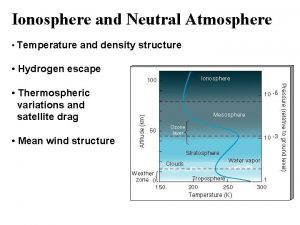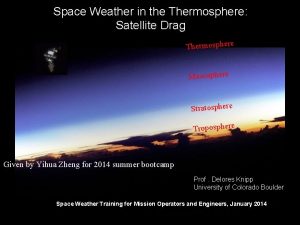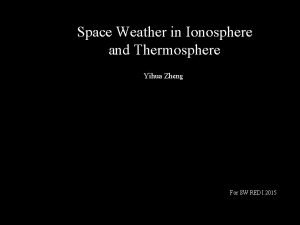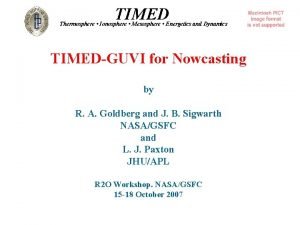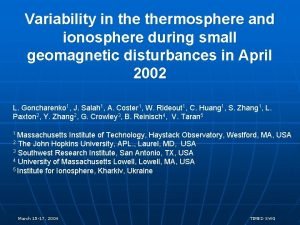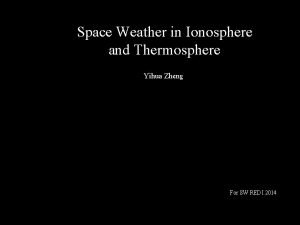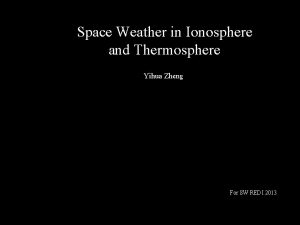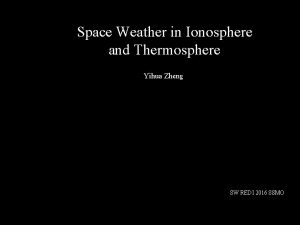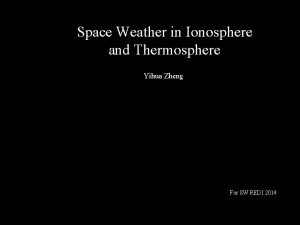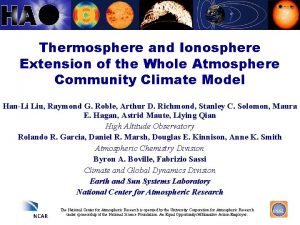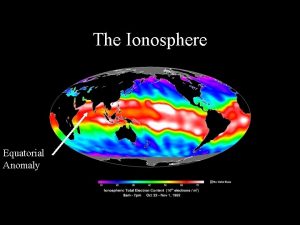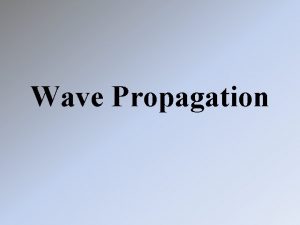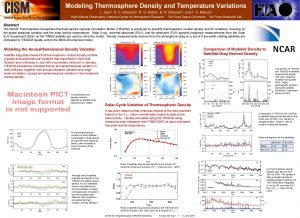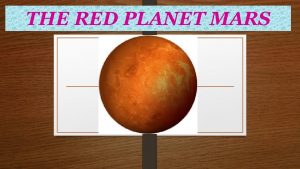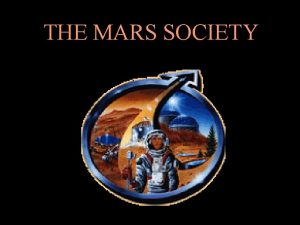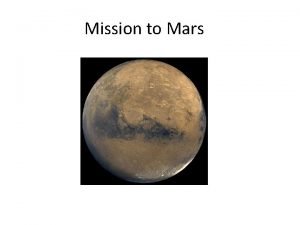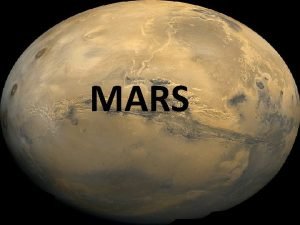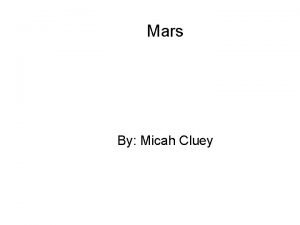Thermosphere and Ionosphere Modeling for Mars MGCMMTGCM Stephen























- Slides: 23

Thermosphere and Ionosphere Modeling for Mars (MGCM-MTGCM) Stephen W. Bougher (UM) Jared Bell Tami Mc. Dunn Brian Steers James R. Murphy (NMSU) 10/6/2020 1

Outline q Why thermosphere-ionosphere modeling is important for Mars (volatile escape & evolution). q Capabilities and limitations of the coupled NCAR/Michigan MGCM-MTGCM framework. q Validation of the MGCM-MTGCM; key features simulated that match available measurements. q Details of SWIM model challenge: inputs to and outputs from the MGCM-MTGCM. q Future SWIM model challenge: ancient Mars. 10/6/2020 2

Martian Atmospheric Regions and Processes 10/6/2020 3

Interaction of Models : Volatile Escape 10/6/2020 4

Mars Upper Atmosphere GCMs q MGCM-MTGCM (e. g. Bougher et al. , 01; 04; 06): • • Flux coupled separate models spanning 0 -300 km NCAR (TIGCM) and NASA Ames (MGCM) heritage. q Mars Whole Atmosphere Climate Model (MWACM) (e. g. Bougher et al; 07 -08) • • Ground to exosphere code (0 -300 km). Earth GITM heritage. Under development q LMD-GCM (e. g. Angelat-i-Coll et al; 04; Gonzalez-Galindo et al. , 05) • • Ground to exosphere code (0 -240 km) LMD/AOPP MGCM heritage; LMD/IAA teaming. q ASPEN (e. g. Crowley et al. 04; 05) • • Troposphere to thermosphere (14 -300 km) NCAR TIME-GCM heritage q GM 3 (e. g. Moudden et al. , 04; 05) • • 10/6/2020 Ground to thermosphere code (0 -160 km) Canadian MET model heritage. 5

MTGCM Formulation and Structure v Altitude range: ~70 -300 km (dayside). Pbot=1. 32 -microbar v 5 x 5º latitude-longitude grid (pole-to-pole) v Pressure vertical coordinate (1/2 -H intervals): 33 -levels v Major Fields: T, U, V, W, O, CO, N 2, CO 2, Z v PCE ions Fields: CO 2+, NO+, CO+, Ne v Current Minor Fields: O 2 and Ar v Future NOx Fields: N(4 S), N(2 D), NO (NO nightglow) v Fox & Sung (2001) ion-neutral chemical reactions & rates. v O, CO and O 2 sources and losses explicitly calculated. v Tion and Telec (empirically based) from Fox [1993]. v NLTE CO 2 15 -micron cooling scheme and near IR heating rates adapted from M. Lopez-Valverde (pc. 2000) 10/6/2020 6

Input Parameters for MTGCM v F 10. 7 ~ 70, 130, 200. Solomon UV routine (2. 4 -225. 0 nm) v Factor for heliocentric distance = 1. 38 -1. 67 (seasonal) v Mars obliquity = ± 25º (seasonal) v Q-Efficiency (EUV, UV) = 22% (after Fox et al. , 1995) v K(O-CO 2) = 3. 0 x 10 -12 cm 3/sec (at 300 K) v Kzz ≤ 1. 0 -1. 5 x 107 cm 2/sec. Prandtl # = 1. 0 v Assumes Grav = 3. 5 m/s 2 over domain v Timestep = 120. 0 secs v PE secondary ionization factors utilized 10/6/2020 7

Coupled MGCM-MTGCM q. Flux coupled codes: NASA Ames MGCM (0 -90 km) and NCAR- Michigan MTGCM (~70 -300 km), linked across an interface at 1. 32 -microbars on a regular 5 x 5º grid. q. Fields passed upward at interface (T, U, V, Z) on 2 -min time-step intervals. No downward coupling enabled. q. Coupling captures upward propagating migrating & nonmigrating tidal oscillations, as well as in-situ solar EUV-UVIR heating (migrating tides). q. Ls = 60 -120 (~Aphelion) & Ls = 270 -300 (~Perihelion) v. Empirical TES horizontal dust distributions (LAT vs LON). v. Conrath parameter scheme used to specify vertical dust distributions (mixed to ~20 -60 km). v. Circulation sensitive to vertical dust dist. (Bell et al. 2007) 10/6/2020 8

Martian Lower Atmos. Dust Opacities for Three Consecutive TES Years (Bell et al. , 2007) 10/6/2020 9

Exploring the Mars Upper Atmosphere With Aerobraking Accelerometers Aerobraking Spacecraft Vertical Structures Seasonal (Ls) Coverage F 10. 7 (at Earth) MGS 1 (1997 -1998) 7 -months 400 (~115 -160 km) 180 -300 70 -90 (MIN) MGS 2 (1998 -1999) 4. 5 -months 1200 (~110 -160 km) 30 -95 130 -150 (MOD) Odyssey (2001 -2002) ~3 -months 650 (~95 -150 km) 260 -310 ~175 -200 (MAX) MRO (2006) 5 -months 900 (~95 -170 km) 35 -109 80 -100 (MIN) 10/6/2020 10

Accelerometer Temp. Variations at 120 km (Bougher et al. , 2006) 10/6/2020 11

Zonal Mean Temperatures and Dynamical Heating Terms from MGCM-MTGCM : (a) MGS 2 (Ls = 90), and (b) ODY (Ls = 270) Temperatures (K) Winter Heating/Cooling (K/day) Summer S +400 K/d Summer 10/6/2020 Winter 800 -2000 K/d 12

MTGCM: No Lower Boundary Forcing (Ls = 270): Temperatures (K) and adiabatic heat/cooling (K/day). Summer Bell et al. (2007) Winter polar warming gone Meridional winds reduced (by ~50%) Reduced max heating (+400 K/d) 10/6/2020 13

MRO Nightside (SLT = 3 -4, LAT=0 -40ºS) and MGS 2 Dayside (LST = 15 -17, LAT= ± 40º) (Keating et al. , 2007) Dayside Mis-Match : • HP > HD issue • O/CO 2 ratio differences? • EUV efficiency ~ 20% needed? 10/6/2020 14 7

MTGCM Thermal Balances: Dayside MGS 2 (LAT = 22. 5ºS LST = 1500) ADIA COND 10/6/2020 QEUV 15

Earth-Mars Comparative Response to Long-Term Changes in Solar flux (Forbes et al. , 2007) Mars - MGS Ls variation removed Earth - msise 90 40 o latitude 10/6/2020 Mars is ~36% - 50% as responsive to solar flux received at the planet, compared to Earth, consistent with Forbes et al. (2006) 16

MGS Comparison with DTM-Mars and MTGCM Results (Forbes et al. , 2007) Latest MTGCM result -50 o 1400 LT (Bougher) DTM Noon MGS orbit ~370 x 425 km periapsis near -40 o to -60 o 1400 LT MGS Fit DTM Midnight 10/6/2020 17

MTGCM Temperature Profiles: Ls = 90 -120; LST = 2. 6 -4. 8; LAT = 17 S-16 S Mc. Dunn et al. , 2007; 2008 10/6/2020 18

MTGCM Z. M. Heat Balance Terms: Ls = 90 -120; LST = 2. 6 -4. 8; LAT = 17 S-16 S COND ADIA CIR Mc. Dunn et al. , 2007; 2008 Rate (K/day) 10/6/2020 19

Dust Storm Impacts: Density at 130 km (Bougher et al. , 1999) MGS Orbit Number 10/6/2020 20

MTGCM Inputs to SWIM Model Challenge v F 10. 7 ~ 130 (solar moderate fluxes) v Ls = 180º; Ds-m = 1. 466 AU (Equinox) v TES Mapping Year #1 dust opacities (Smith, 2004) v Q-Efficiency (EUV, UV) = 22% (Fox et al. , 1995) v K(O-CO 2) = 3. 0 x 10 -12 cm 3/sec (at 300 K) v Kzz ≤ 1. 0 x 107 cm 2/sec. Prandtl # = 1. 0 10/6/2020 21

MTGCM Outputs for SWIM Model Challenge v. SZA Method – – – Neutral Fields (6) = T, O, CO, N 2, CO 2, XTOT Ion Fields (3) = O 2+, O+, Ne Altitudes ~ 100 to 260 by 5. 0 km Longitudes = -180 to 180º by 5º SLT = 0 to 12 to 24 hours (at Latitude = 2. 5 N) SZA = 180 to 180º v. Constant Altitude (Lat vs Lon) Method – – – 10/6/2020 Same fields (6 -neutral and 3 -plasma) plus O 2+ production. Altitudes ~ 100 to 260 by 5. 0 km Longitudes = -180 to 180º by 5º Latitudes = -87. 5 S to +87. 5 N by 5º 22

Conclusions and Summary q 3 -D thermosphere-ionosphere model outputs are important for volatile escape & evolution studies (hybrid, MHD, airglow, exosphere, sputtering, etc) q MGCM-MTGCM validation is ongoing using aerobraking (MGS/Odyssey/MRO), drag (MGS) and stellar occultation (MEX) datasets. Reasonable. q MGCM-MTGCM outputs are provided for SWIM model challenge (present day). 2 -D and 3 -D grids. q Future SWIM model challenge: ancient Mars. 10/6/2020 23
 Troposphere stratosphere mesosphere thermosphere exosphere
Troposphere stratosphere mesosphere thermosphere exosphere Role modeling theory
Role modeling theory The thermosphere blocks deadly
The thermosphere blocks deadly Ionosphere height
Ionosphere height Thermosphere pictures
Thermosphere pictures Ionosphere
Ionosphere Ionosphere
Ionosphere Jdiss
Jdiss Ionosphere
Ionosphere Ionosphere
Ionosphere Thermosphere
Thermosphere Drag force
Drag force Stratosphere height
Stratosphere height Vertical division of atmosphere
Vertical division of atmosphere Ionosphere
Ionosphere Dimensional modeling vs relational modeling
Dimensional modeling vs relational modeling Fspos
Fspos Typiska novell drag
Typiska novell drag Tack för att ni lyssnade bild
Tack för att ni lyssnade bild Ekologiskt fotavtryck
Ekologiskt fotavtryck Varför kallas perioden 1918-1939 för mellankrigstiden?
Varför kallas perioden 1918-1939 för mellankrigstiden? En lathund för arbete med kontinuitetshantering
En lathund för arbete med kontinuitetshantering Särskild löneskatt för pensionskostnader
Särskild löneskatt för pensionskostnader Tidbok för yrkesförare
Tidbok för yrkesförare
